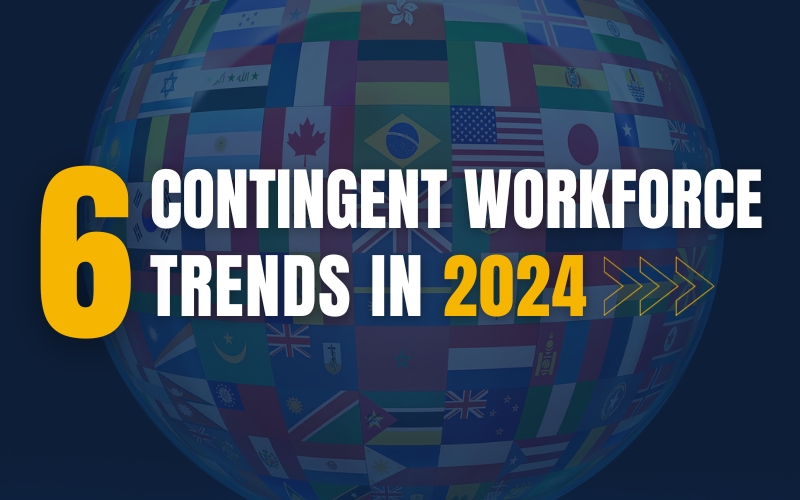In our constantly shifting digital world, trends no longer move as slowly as they did the past few decades. They zip by, often too quickly for businesses to predict or prepare for them. But if employers can get a handle on some of these workplace trends, especially as they relate to the future of the contingent workforce, they will find themselves enjoying a competitive hiring edge in an often chaotic marketplace.
Why Is It So Important to Understand Contingent Workforce Trends?
In a 2023 survey, company leaders across the globe said they planned to use more contingent workers — 65% said they would increase their use of contingent workers in the upcoming two years. Plus, 80% of those surveyed were already using contingent workers. However, 70% were facing challenges when integrating contingent workers into their workforces.
In light of these numbers, it will benefit both employees and employers to stay informed and curious about contingent workforce trends. The employment landscape changes almost every month, and the professionals who keep a trained eye on these shifts will be more prepared to proactively enter the future of a contingent workforce.
Understanding the present and being able to predict the future allows teams to support their own evolving business needs, match supply and demand, innovate successfully, make healthy financial decisions, and continue to reach and engage their customers.
Moreover, understanding trends becomes very helpful — sometimes even urgent — in a world where consumer behavior and human interests can pivot and grow rapidly. Businesses are operating in digital territory now, and they’re coming to terms with new technologies and new modes of working. These include remote, hybrid, and flexible working trends, all of which are impacting contingent workforce programs.
6 Contingent Workforce Trends to Watch for in 2024
Here are the six biggest trends we see impacting the future of the contingent workforce that leaders should keep an eye on:
1. Upskilling employees
A trend we saw developing in 2023 that will continue in 2024 is upskilling. The rapid introduction and adoption of technologies, like generative AI, into our workplaces mean that many employers and workers cannot remain experts for very long without training. In fact, according to recent research, nearly 7 in 10 HR professionals are suffering from skills gaps.
A culture of continuous learning is needed. This goes for both internal and external workers, full-time and contingent workforces. Everyone will need regular opportunities to enhance their skills to keep up with the changing times.
Furthermore, the rise of gig economy platforms and remote work opportunities expands the scope for contingent workers to engage in a broader spectrum of industries and roles. This diversity of opportunities demands a matching diversity in skills. Companies, in recognizing the growing importance of this flexible workforce, might invest in upskilling programs accessible to contingent workers. Such initiatives could include online courses, micro-credentialing, and project-based learning experiences, offering contingent workers the same opportunities for growth and development as their full-time counterparts.
2. Skills-based hiring
Thanks to this skill gap, skills-based hiring continues to grow in popularity. According to a 2023 report by TestGorrilla, 70% of employers agree that skills-based hiring is more effective than sifting through résumés.
A skills-based approach also fits into other developing flexible working trends. Tapping into or implementing a strong contingent workforce program is a great way to fill skills gaps. Engaging an independent contractor or W-2 employee to fill the need for a particular skill allows organizations to add that talent while keeping headcount flexible.
Employers looking to find contingent workers to fill specific skills can leverage a variety of strategies. One effective approach is utilizing specialized freelance platforms and job boards that cater to contingent workers. These platforms allow employers to access a vast pool of talent with varied skill sets and engage with professionals who have the exact expertise needed for a project. Another strategy is reaching out to professional networks or industry groups, which can provide recommendations for specially skilled contingent workers. Additionally, partnering with an employer of record that specializes in contingent worker engagement can streamline the process, as these agencies often have a direct sourcing strategy that can help employers source by the skills they need.
3. Hiring in emerging markets
The global contingent workforce is rapidly expanding, thanks in part to a variety of online platforms that facilitate connections between employers and talent worldwide. Platforms like Upwork and Toptal stand out as key facilitators in this arena. Upwork, for instance, offers a vast marketplace where employers can find freelancers with a wide array of skills, from web development to graphic design, enabling them to supplement their contingent workforce needs with ease. Toptal, on the other hand, focuses on connecting businesses with the top 3% of freelance talent, specializing in software development, finance, and project management.
Additionally, the rise of global EOR services complements these platforms. EOR services enable companies to legally and efficiently employ talent in countries where they don’t have business entities. This arrangement is particularly beneficial for tapping into talent pools in emerging markets. Employers can leverage EOR services to handle complex aspects of employment, such as payroll, taxation, and compliance with local labor laws, thereby simplifying the process of engaging with a global contingent workforce. Companies that previously only focused their hiring efforts on a certain geographical area can now think globally and use online platforms to reach a worldwide audience.
Africa, for example, has seen a rise in hiring for IT, graphic design, and writing skills-based jobs. In sub-Saharan Africa, job postings on the area’s largest digital platform grew by 130% in 2023, while the growth rate in North America was just 14%. As wage expectations continue to rise, due in part to inflation in some of the wealthier countries around the world, we will see opportunities arise in less developed countries.
4. A focus on compliance
Smart companies and HR teams are spending more time and care on compliance regulations this year largely because the legislative world continues to get more complex, with new regulations for employment coming into existence all the time.
The regulatory compliance around freelancers is not something to take lightly. As gig platforms like Instacart and Uber continue to fight their legislative battles, it will be important for employers to pay attention to legislation cases and changes around the world.
While making sure their compliance is sound in-house, companies should also check that their staffing agencies or EOR partners have reliable practices in place to make sure they are compliant. It is just as crucial for a business’s contingent workforce to be compliant as it is for its internal staff. If a company has a large independent contractor population as part of its contingent workforce population, leaders should be sure those workers are vetted properly and annually (at the very least).
5. Understanding multigenerational workforces
In preparing for contingent workforce program implementations, employers are realizing that the employment landscape of the future is multigenerational. If companies are only shaped by their Baby Boomers, they will likely miss out on top talent from other generations, who are rapidly stepping into new roles and career changes.
Research predicts that more than a quarter of the workforce will be Gen Z (ages 11 to 26 in 2023) by 2025. This generation famously cares about work-life balance, DEI initiatives, and sustainability. As a group, Gen Zers also need to feel a sense of purpose in their work, and this goes for both full-time and contingent workers. Gen Z’s emphasis on flexibility, work-life balance, and purpose-driven work aligns well with the nature of contingent roles, which often offer more flexibility than traditional full-time positions. However, employers must consider how to integrate these contingent roles into their broader organizational culture and DEI initiatives to attract top talent from this generation.
By understanding and responding to the unique characteristics of each generation, employers can build a more inclusive, effective, and dynamic contingent workforce capable of driving innovation and growth in an increasingly diverse and multigenerational employment landscape.
6. Increased use of AI
The rise of artificial intelligence has dominated 2023 workplace news, and it’s set to be even more impactful in 2024. In the realm of HR, AI is likely to have an impact on talent acquisition, and platforms like WorkLLama and Opptly, which implement AI into their RPO services and sourcing strategies, will become easier and more engaging for employers and employees. AI is already improving the hiring process by screening résumés and scheduling interviews, leaving hiring managers more time to do the important work of building rapport and assessing cultural fit.
The integration of AI into workforce management is particularly significant for the contingent workforce. AI’s capabilities in automating and streamlining processes are highly beneficial for managing these workers, whose employment arrangements are often more fluid and dynamic compared to traditional full-time roles. For instance, AI can assist in rapidly matching contingent workers with suitable projects based on their skills and past work experiences, enhancing the efficiency of the talent acquisition process.
Additionally, AI-driven platforms can facilitate onboarding, scheduling, and even performance tracking for contingent workers, tailoring these processes to suit the unique nature of nonpermanent roles. AI can also provide critical insights into the utilization and productivity of contingent workers, helping companies optimize their workforce strategies and better understand the contributions of these flexible employment arrangements.
It is no longer enough to have “traditional” business knowledge or a foundational understanding of the employment landscape, especially the contingent workforce. Company leaders need a more dynamic, flexible kind of knowledge to compete with the changeable nature of the market.
With workforce dynamics continuing to evolve around the world, learn how IES can help your organization compliantly navigate the world of work. Contact us today!
Written by: Kara Hertzog, President of IES
Kara Hertzog is president of Innovative Employee Solutions (IES), a leading provider of remote and contingent workforce solutions specializing in global Employer of Record, Agent of Record, and Independent Contractor compliance services in 150+ countries. Founded in 1974, IES is a woman-owned business, certified by the WBENC, and partners with companies to provide compliant employment solutions that empower people’s lives.







